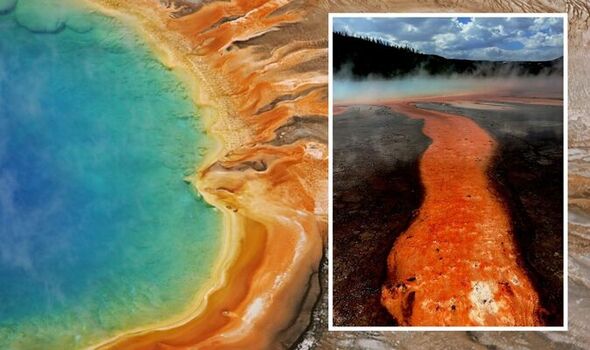
Yellowstone volcano’s magma chamber mapped in documentary
Supervolcanoes have a Volcanic Explosivity Index [VEI] of eight, the highest value on the Index. It is a logarithmic scale, so an increase of one in VEI number is the equivalent to a tenfold increase in volume of erupted material. The Mount St. Helens eruption of 1980, which caused around $3.5billion (£2.575billion) worth of damage, measured five on the VEI.
Mount Tambora, the biggest recorded eruption in history, recorded seven on the VEI.
The three caldera-forming eruptions at Yellowstone, one of 20 known supervolcanoes on Earth, were each around 1,000 times larger than Mount St. Helens.
Yellowstone erupted 2.1 millions years ago, 1.3 million years ago and approximately 640,000 years ago.
Based on this cycle, it is ‘due’ to an eruption, though there are no signs that this will happen any time soon.
READ MORE: Russia missile warning as RAF fears UK’s warning systems thwarted

Yellowstone supervolcano: Scientists pinpoint ‘first sign’ of imminent eruption (Image: GETTY)

Previous eruptions at Yellowstone were 1000x more powerful than Mount St. Helens. (Image: GETTY)
Nonetheless, Naked Science’s 2004 documentary ‘Super Volcanoes’ explored what would happen in the event of an eruption.
All volcanoes warn that they are about to erupt, explained the documentary’s narrator.
He said: “The first sign of a Yellowstone eruption would probably be the ground rising.
“Just before Mount St. Helens erupted, the mountain bulged, growing five feet per day.

Illustration shows a section through the earth during a supereruption. (Image: GETTY)
“A similar kind of uplift would be likely at Yellowstone. As magma deep below the surface of the Earth rises, it splits the rocks above.
“In Yellowstone, it would probably lift the whole caldera — an area the size of Houston and Dallas — 10 feet into the air.”
Such warning signs, the documentary explained, would trigger “the mother of all evacuations”.
The area 60 miles around the volcano would become a hazard zone, and officials would place the surrounding region — up to 200 miles — on alert.
DON’T MISS:
Yellowstone eruption: ‘Normal life within 500 miles impossible’ [EXPERT]
Yellowstone supervolcano warning after magma chamber discovery [INSIGHT]
Yellowstone eruption warning: Human brains could be ‘popped apart’ [QUOTES]

The hot springs at Yellowstone. (Image: GETTY)
The narrator continued: “As people evacuated the area, geologists would look out for new warning signs that would tell them an eruption is imminent.”
Professor Bill McGuire, one of the UK’s leading volcanologists, said: “You would start to see swarms of earthquakes as fresh magma moves into the system and breaks the rock above it and starts to rise upwards.”
These earthquakes would produce distinctive waveforms on the seismographs. The crack of rocks fracturing creates a waveform that begins with a sharp rise and fades quickly.
Long before an eruption, the hazard zone and surrounding area would be hit by these earthquakes.

Yellowstone’s Grand Prismatic Spring. (Image: GETTY)
Just before an eruption, these earthquakes would give way to a new signal — a long, continuous vibration.
Prof McGuire explained: “Now when magma’s opened a space for itself, it will start to move through that.
“And as it moves through that, fairly rapidly, it will vibrate the walls of the crack or the conduit, and that will give you a rumbling signal.”
The vibration, which sounds like a large organ pipe, is called a harmonic tremor. This is the final warning before an eruption.
The documentary’s narrator said: “For anyone brave or foolish enough to remain in the hazard zone, the chances of escape would be slim. The big bang would be moments away.”
The eruption itself would undoubtedly be huge, but nothing in comparison to the subsequent pyroclastic flow, often dubbed the “wall of death” that engulfed the ancient Roman city of Pompeii.
Analysis of earthquake data at Yellowstone in 2013 found that the magma chamber is 80m (50miles) long and 20km (12miles) wide. It also has an estimated underground volume of 4,000km³, two and a half times bigger than previously imagined.
However, the analysis also said the proportion of molten rock in the chamber is too low to allow for another supereruption.
This was refuted by research from the Arizona State University in 2017, which indicated Yellowstone’s magma reservoir can undergo ‘rapid change’ — by supervolcano standards — and can reach eruptive capacity within decades.





More Stories
POLL: Would you install a hydrogen-ready boiler in your home?
Hearses line the streets of Beijing as China’s Covid crisis causes crematorium backlog
London Defender Person Of The Year Is Genius Inventor Andre Gray 2022